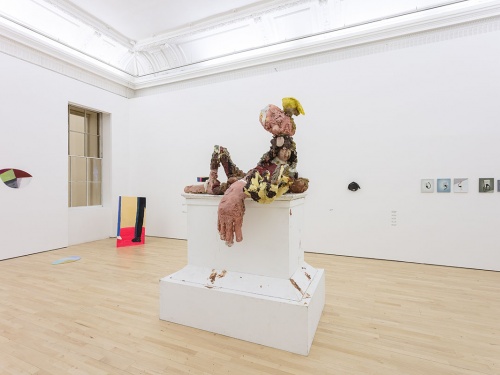Constructive Spaces
Three perspectives on curating virtual reality
Ahead of the launch of their VR exhibition, Kate Gu,William Webster and ICA Student Forum member Cristina Vasilescu discuss virtual reality as an exhibition platform and the role of the curator within it.
Kate Gu
Thanks to the constant development of new technologies that are then wielded as powerful tools by artists, flourishing new media art continuously satiates our eyes and senses in various forms, while curatorial practice still mainly remains an invisible hand behind. Given the context, this exhibition was born as an audacious experiment to adopt virtual reality as the technology to open up new dialogue and usher the unpredictable path for future curatorial practice. The show is intended to elicit inquiries about authorship: curators trespassing into the field of artists to construct spaces that are distinctive from the conventional white cube in four-dimensional multi-sensory spaces, and blur the sense of measurement and scale in the space by manipulating the sizes and dimensions of objects in the virtual space.
Do curators have a powerful, dangerous and imminent advantage over artists in their manipulation of virtual reality?
Indeed, the technology brings with it numerous possibilities to explore what could be done to enhance the apprehension of the artwork rather than simple appropriation, in which this show is by no means an exemplification, but instead an initiation. The questions asked are: do curators have a powerful, dangerous and imminent advantage over artists in their manipulation of virtual reality? How do we redefine the work of a curator for crossing over to the role of an artist? A filmmaker? Or even a gaming designer?
William Webster
As images flood our spaces, the internal contradictions that have driven photography since its inception have increasingly become a societal concern. Living in a networked condition we are already bounded by intangible frames, in many ways based on the mechanistic reproduction of the camera. Images shuttle meaning like a dumb waiter between sites of production and consumption. Witness the contemporary turn to materiality that marks the photographer’s alarm as imagery becomes ever more ephemeral. Has the spatial grounding of images, the window-like clarity, ever been more displaced?
The constraints of our extended environment maintain their urgency even as we are invited to spend more time in a non-material realm. The bottomless medium of financialisation has pushed the square meter in London to places where it has no value equivalent elsewhere. It seems prudent and necessary then that artists and curators should seek avenues for display in the network, providing a release from material concerns.
Living in a networked condition we are already bounded by intangible frames.
Photographs are at the heart of virtual reality and have multiple roles in the art cycle: a trace that continues a discourse, sometimes cynically nothing more than a illustration to whet the appetite. Rather than forcing the material world into being, the virtual provides a field to update a prescribed linear procession of creation, exhibition and then documentation. The algorithms of photogrammetry, where two-dimensional representations are computed into three-dimensional objects, transform otherwise contextless data sets into an entire cloud of visual references relating to each other.
Such a reordering can provoke fear of alienation, a divorce from the audience that practitioners must find their own place for within their process. The communal exchanges of the kitchen table, an inviolable safe space where discussions flow freely, continue as artists seek access to the outside world. The domestic and vernacular maintains its importance as a site of expression when purpose-built environs are marginalised due to balance sheets. Now institutional frameworks, albeit operating from beyond geographical locations, become more valuable than ever to deliver these subjective experiences in context. Today, the photograph as evidence of what once was, can also point to what could be.
Cristina Vasilescu
Could virtual reality become a place with the capacity to fulfill a person’s innermost desires? Or does the virtual do this already? Introduced in Andrei Tarkovsky’s Stalker, the ‘zone’—a strange place that may trigger personal epiphanies—is there for you to venture in search of inspiration. The zone is now open; virtual reality is real.
As a blurred circuit of reflections and refractions that creates voids and inconsistencies, as well as flourishing possibilities, to curate an exhibition within the intangible has felt uncannily close to the meshes of the zone. This exercise in virtual exhibition-making presents seven artists’ enquiries about space appropriation and procreation and the repurposing of objects and their value. Lugh O’Neill’s accompanying sound piece becomes the aural running energy thread through the editorial of VR.
Could virtual reality possibly become a place with the supposed capacity to fulfill a person’s innermost desires?
The imponderability and lack of gravity of the virtual unconsciously drove us to search for the physical works first. In this case, VR came as a tool in the aftermath of the curatorial concept. The representation of the works in the virtual space, through the use of 3D-scanning, disrupted the curatorial process and its initial concept, leaving them half-swallowed by the virtual itself. Not only does this question the authorship of the artist, but also curatorial agency in a four-dimensional sphere, where the objects may easily be manipulated, misrepresented and drained of content. Yet VR opens up an eerie formula for fantasy narratives and enhanced experiences to swirl in its boundless environment. Welcome to the road towards the zone. ■
The VR exhibition launches Wednesday 7 December, 6pm – 10pm.
This article is posted in: Articles, Exhibitions, Student Forum
Tagged with: Student Forum, Virtual Reality, Curation, BNC 2016








